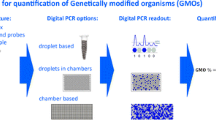Abstract
We investigate the applicability of using digital PCR to estimate absolute limits of detection and quantitation associated with the validation of traditional real-time PCR methods for analysis of genetically modified (GM) ingredients. We also demonstrate the use of dynamic arrays as a precursor in selecting suitable sample dilution levels for accurate copy number assessment using the aforementioned digital PCR. Additionally, we further explore the relevance of digital PCR in accurately quantifying plasmid copy numbers associated with a commercially available Certified Reference Material. The use of digital PCR has the advantage of facilitating absolute single molecule detection, therefore negating the necessity for standards on a calibration curve, and reducing associated matrix effects. The approaches described in this paper enable pre-existing validated protocols to be re-examined, and estimates based on an alternative approach using digital PCR to be used in order to objectively characterise sensitivity limits.



Similar content being viewed by others
References
Burns M (Ed) EU Co-Extra Task 4.2 report (2009) Procedure for the experimental design and validation of novel methods and guidelines for data processing, method validation and good data handling practices. CO-EXTRA: GM and non-GM supply chains: their CO-E**stence and TRAceability. Project number: 007158, Integrated project, Sixth Framework Programme, Priority 5, Food Quality and Safety. http://www.coextra.eu/deliverables/deliverable1333.pdf
Burns M, Corbisier P, Wiseman G, Valdivia H, McDonald P, Bowler P, Ohara K, Schimmel H, Charels D, Damant A, Harris N (2006) Comparison of plasmid and genomic DNA calibrants for the quantification of genetically modified ingredients. Eur Food Res Technol 224(2):249–258
Burns M, Valdivia H, Harris N (2004) Analysis and interpretation of data from real-time PCR trace detection methods using quantitation of GM soya as a model system. Anal Bioanal Chem 378(6):1616–1623
BioMark Digital PCR Analysis Software User Guide. Fluidigm (Fluidigm Corporation, San Francisco)
Bhat S, Herrmann J, Armishaw P, Corbisier P, Kerry ER (2009) Single molecule detection in nanofluidic digital array enables accurate measurement of DNA copy number. Anal Bioanal Chem. doi:10.1007/s00216-009-2729-5
Certification report: Certification of plasmidic DNA containing MON 810 maize DNA fragments, Certified Reference Materials ERM®-AD413 (2007) EUR 22948 EN, ISBN 978-92-79-07139-3, ISSN 1018-5593. doi:10.2787/49996. Luxembourg: Office for Official Publications of the European Communities, © European Communities, 2007
Community Reference Laboratory for GM Food and Feed. European Commission, Joint Research Centre. CRL assessment on the validation of an event specific method for the relative quantitation of maize line MON 810 DNA using real-time PCR as carried out by Federal Institute for Risk Assessment (BfR) http://gmo-crl.jrc.ec.europa.eu/summaries/Mon810_validation_report.pdf
BioMark™ Digital PCR Workflow Quick reference, 2009 Fluidigm (Fluidigm Corporation, San Francisco)
BioMark™ Advanced Development Protocol 10. Absolute quantitation using the digital array. Fluidigm (Fluidigm Corporation, San Francisco)
48.48 Dynamic array—gene expression. http://www.fluidigm.com/pdf/fldm/FLDM_MRKT00065.pdf
BioMark™ Advanced Development Protocol 9. Calculating copy number using a 12.765 digital array. Fluidigm (Fluidigm Corporation, San Francisco)
Dube S, Qin J, Ramakrishnan R (2008) Mathematical analysis of copy number variation in a DNA sample using digital PCR on a nanofluidic device. PLos ONE 3(8):e2876
Ellison S, English C, Burns M, Keer J (2006) Routes to improving the reliability of low level DNA analysis using real-time PCR. BMC Biotechnol 6:33. doi:10.1186/1472-6750-6-33
Community Reference Laboratory for GM Food and Feed, Guidance Document. Definition of Minimum Performance Requirements for Analytical Methods of GMO Testing (2008). http://gmo-crl.jrc.ec.europa.eu/doc/Min_Perf_Requir_Analyt_methods_131008.pdf
Acknowledgments
The work described in this paper was supported by the UK Department for Business, Innovation and Skills (BIS) as part of the “Government Chemist 2008–2011 Programme”. The authors gratefully acknowledge funding provided by the 6th EU Framework Programme for Research and Technological Development (FP6) project “GM and non-GM supply chains: their CO-Existence and TRAceability” (Contract number 007158).
Author information
Authors and Affiliations
Corresponding author
Rights and permissions
About this article
Cite this article
Burns, M.J., Burrell, A.M. & Foy, C.A. The applicability of digital PCR for the assessment of detection limits in GMO analysis. Eur Food Res Technol 231, 353–362 (2010). https://doi.org/10.1007/s00217-010-1277-8
Received:
Revised:
Accepted:
Published:
Issue Date:
DOI: https://doi.org/10.1007/s00217-010-1277-8




